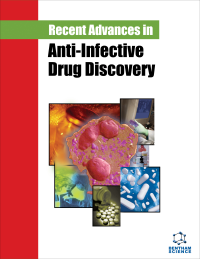- Home
- A-Z Publications
- Recent Advances in Anti-Infective Drug Discovery
- Previous Issues
- Volume 18, Issue 1, 2023
Recent Advances in Anti-Infective Drug Discovery - Volume 18, Issue 1, 2023
Volume 18, Issue 1, 2023
-
-
Medicinal Plants as Natural Anti-Parasitic Agents Against Blastocystis Species
More LessAuthors: Nagwa Mostafa El-Sayed and Nagham Gamal MasoudBackground: Blastocystis species (sp.) are enteric parasites that live in both humans' and animals' gastrointestinal tracts. Blastocystis hominis (B. hominis) is the recognizable human isolates in clinical and diagnostic specimens. Human infection occurs via the oro-fecal route, particularly in developing areas due to the lack of sanitation and hygienic facilities. B. hominis can exist in the large intestine for weeks to years until tr Read More
-
-
-
Pulegone: An Emerging Oxygenated Cyclic Monoterpene Ketone Scaffold Delineating Synthesis, Chemical Reactivity, and Biological potential
More LessAuthors: Ashwani K. Dhingra and Bhawna ChopraPulegone ((R)-5-Methyl-2-(1-methylethylidine) cyclohexanone) is a pharmacologically active, natural monoterpene ketone obtained from leaves and flowering tops of the mint family (Lamiaceae). The aim is to comprise the physicochemical and biological aspects of pulegone. All significant databases were collected via electronic search using Pubmed, Scopus, Web of Science, and Science Direct and were compiled. This revi Read More
-
-
-
Multidrug-Resistant Acinetobacter baumannii: An Emerging Aspect of New Drug Discovery
More LessAuthors: Khushi R. Mittal, Nandini Jain, Poornima Srivastava and Chakresh K. JainBackground: Acinetobacter baumannii is an opportunistic multidrugresistant, aerobic, glucose non-fermentative, and oxidative-negative coccobacilli bacteria. This life-threatening nosocomial infection is associated with immunocompromised patients. Objective: This review aims to investigate the multiple drug resistance mechanisms and new emerging diagnostics & treatments for Acinetobacter baumannii. Methods: All the article Read More
-
-
-
Whether Early Steroid dose is Associated with Lower Mortality in COVID-19 Critically Ill Patients-An Exploratory Chart Review
More LessIntroduction: Steroids have shown its usefulness in critically ill COVID-19 patients. However, the time of starting steroid and dose tailored to severity remain a matter of inquiry due to still emerging evidences and wide-ranging concerns of benefits and harms. We did a retrospective record analysis in an apex teaching hospital ICU setting to explore optimal doses and duration of steroid therapy which can decrease mortality. Read More
-
-
-
Triggers for Acceptance of COVID-19 Vaccination: A Community- Based Study
More LessBackground: COVID- 19 vaccines have been released, giving a major hope of getting rid of the dark pandemic crisis. The availability of vaccines does not necessarily mean that the mass vaccination program is a success. We aimed to investigate COVID-19 vaccination knowledge level, acceptance rate, and perception state among Egyptians. Methods: An analytical cross-sectional online survey was carried out utilizing a Read More
-
-
-
An Integrated Approach to Identify Intrinsically Disordered Regions in Osteopontin with its Interacting Network in Rheumatoid Arthritis
More LessAuthors: Parul Johri, Sachidanand Singh, Prachi Sao, Sudeshna Banerjee, Mala Trivedi, Aditi Singh and Irena KostovaBackground: Credentials of molecular diagnostic approaches are an important goal. Since protein-protein interaction (PPI) network analysis is an apposite method for molecular valuation, a PPI grid related to Intrinsically Disordered Proteins (IDPs) of RA was targeted in the present research. Aim: The aim of the study is to analyse the role of highly disordered proteins and their functional parameters in causing Rheumatoid Art Read More
-
Volumes & issues
Most Read This Month
Article
content/journals/raaidd
Journal
10
5
false
en


